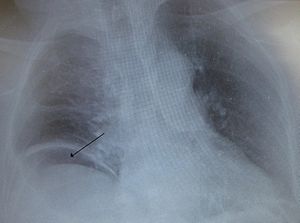Perforated intestine
| Gastrointestinal perforation | |
|---|---|
| Synonyms | Ruptured bowel, gastrointestinal rupture |
 |
|
| Free air under the right diaphragm from a perforated bowel. | |
| Specialty | Gastroenterology, emergency medicine |
| Symptoms | Abdominal pain, tenderness |
| Complications | Sepsis, abscess |
| Usual onset | Sudden or more gradual |
| Causes | Trauma, following colonoscopy, bowel obstruction, colon cancer, diverticulitis, stomach ulcers, ischemic bowel, C. difficile infection |
| Diagnostic method | CT scan, plain X-ray |
| Treatment | Emergency surgery in the form of an exploratory laparotomy |
| Medication | Intravenous fluids, antibiotics |
| Prognosis | Risk of death up to 50% |
| Classification |
· ·
|
|---|---|
| External resources |
Gastrointestinal perforation, also known as ruptured bowel, is a hole in the wall of part of the gastrointestinal tract. The gastrointestinal tract includes the esophagus, stomach, small intestine, and large intestine. Symptoms include severe abdominal pain and tenderness. When the hole is in the stomach or early part of the small intestine the onset of pain is typically sudden while with a hole in the large intestine onset may be more gradual. The pain is usually constant in nature.Sepsis, with an increased heart rate, increased breathing rate, fever, and confusion may occur.
The cause can include trauma such as from a knife wound, eating a sharp object, or a medical procedure such as colonoscopy, bowel obstruction such as from a volvulus, colon cancer, or diverticulitis, stomach ulcers, ischemic bowel, and a number of infections including C. difficile. A hole allows intestinal contents to enter the abdominal cavity. The entry of bacteria results in a condition known as peritonitis or in the formation of an abscess. A hole in the stomach can also lead to a chemical peritonitis due to gastric acid. A CT scan is typically the preferred method of diagnosis; however, free air from a perforation can often be seen on plain X-ray.
...
Wikipedia
